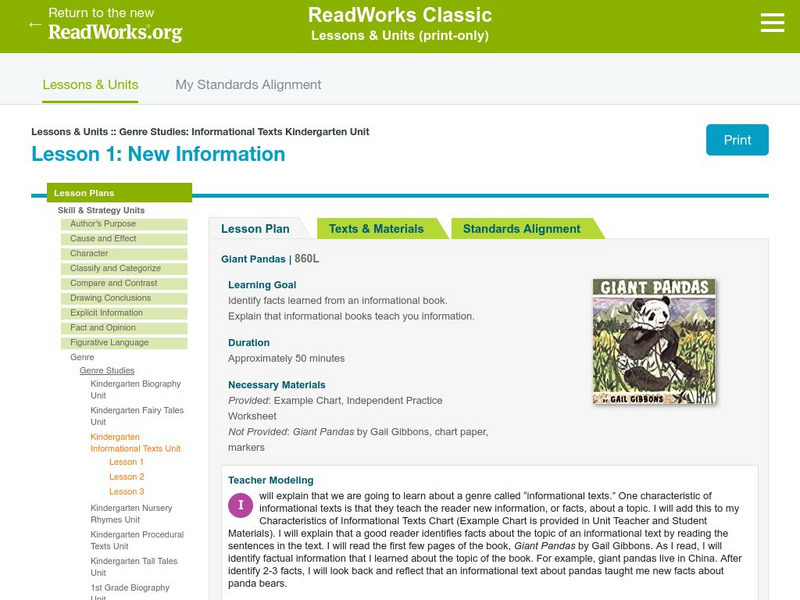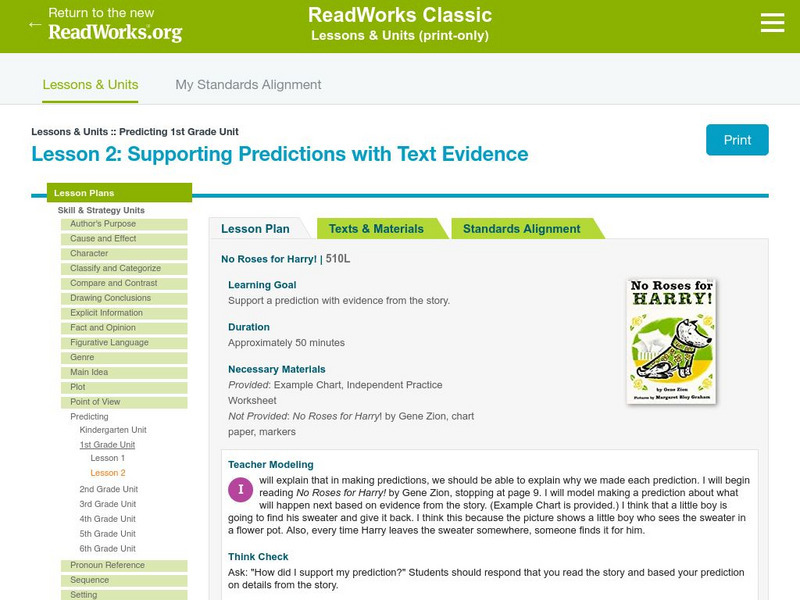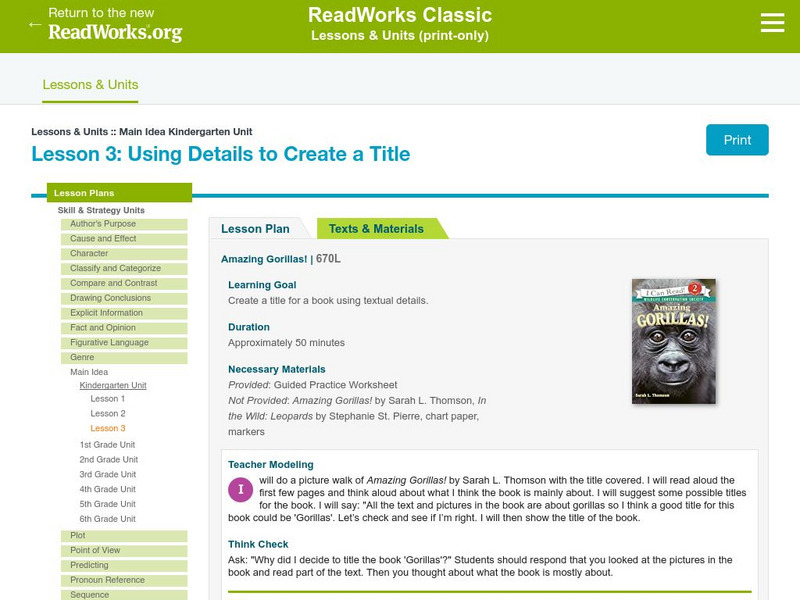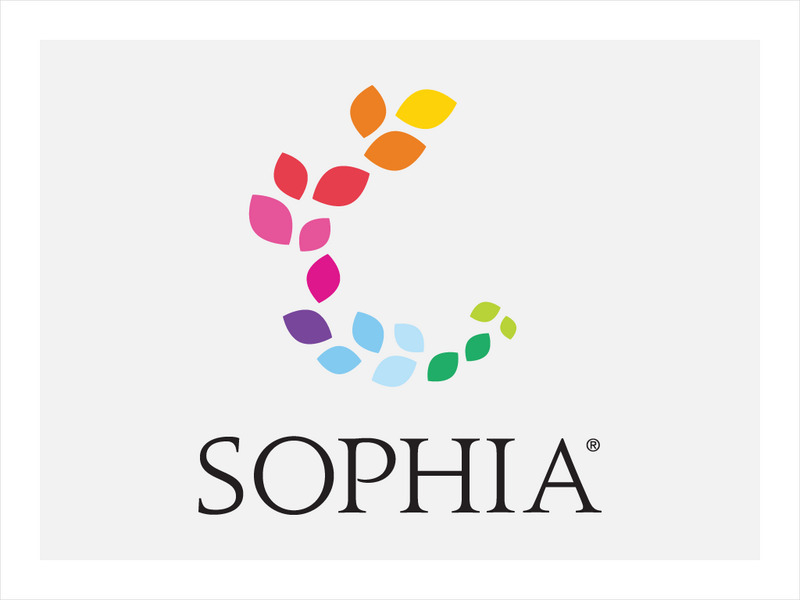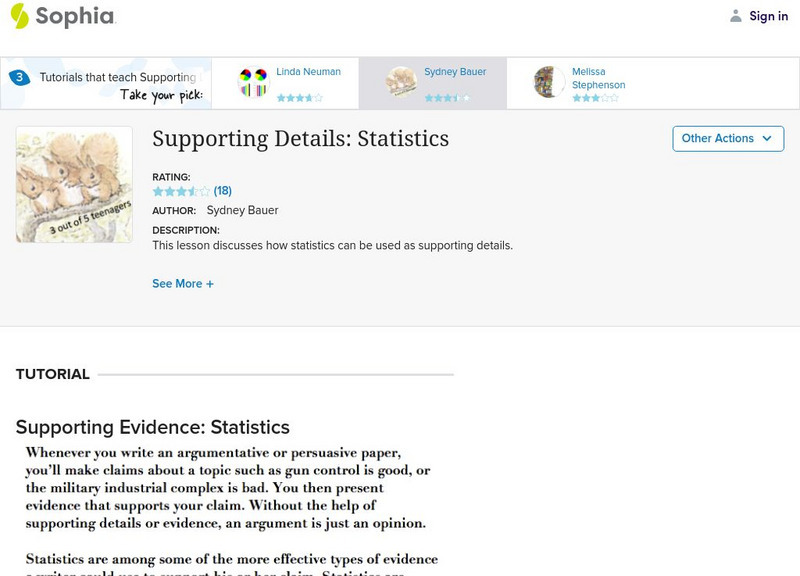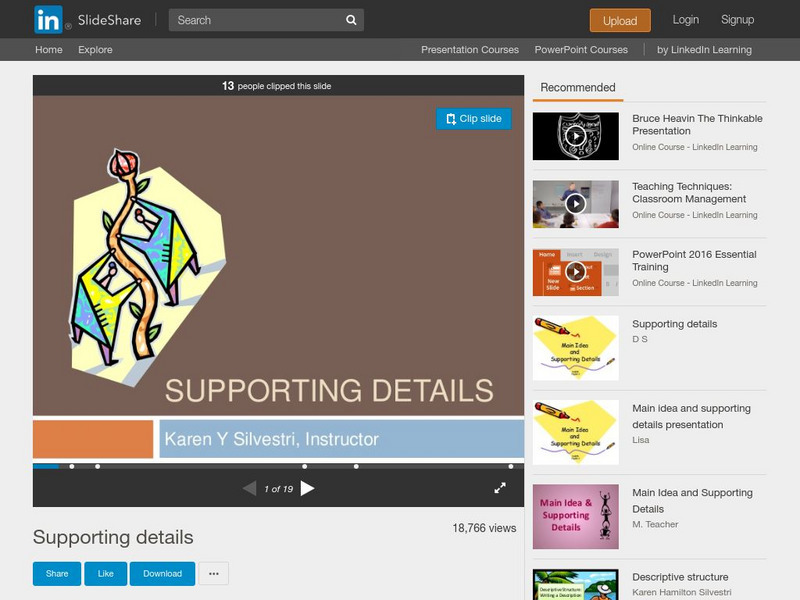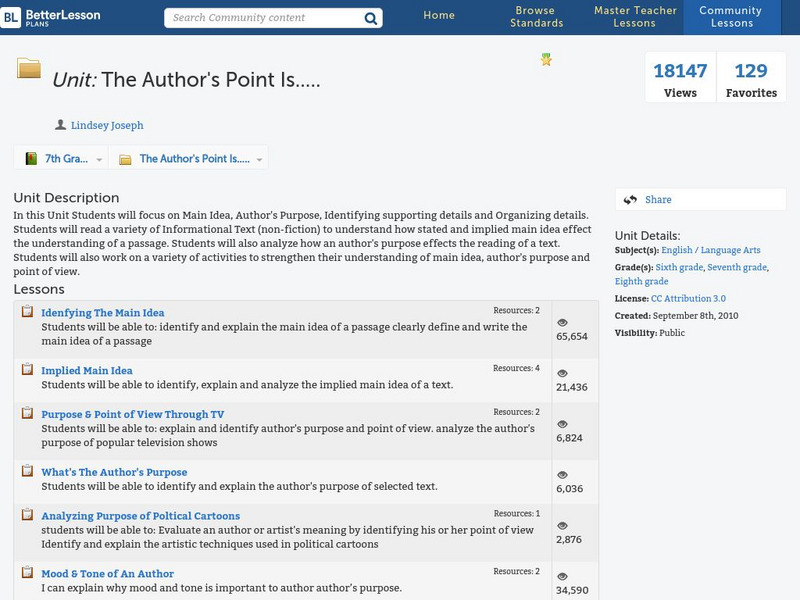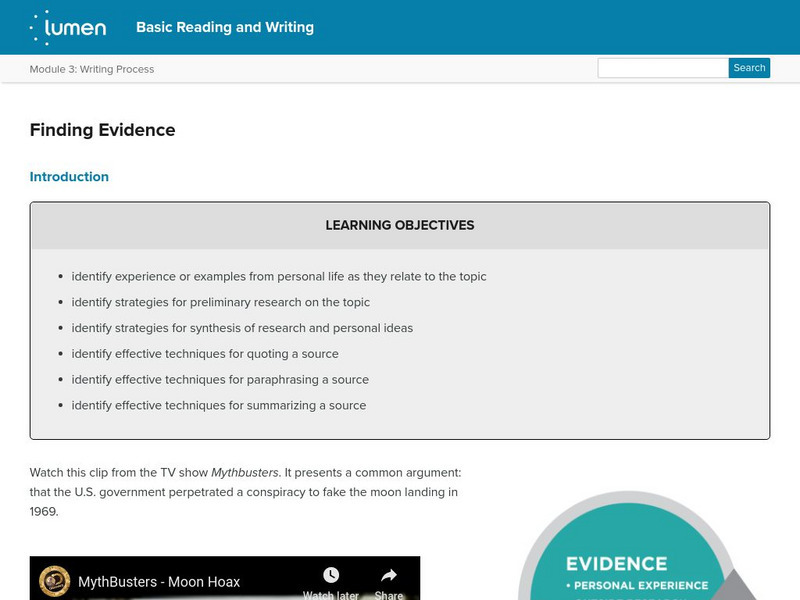Other
Scribd.: Kindergarten Reading Comprehension Lesson Plan: Main Idea and Details
A five-day lesson plan to teach students how to find the main idea of a story and generate a title, identify facts and details from a story, and differentiate between main idea and supporting details.
Education Development Center
Tv411: Summarizing: Activity 3
In this activity, students choose the correct category to which details belong. Being able to categorize helps students to identify the difference between main ideas and details.
Read Works
Read Works:genre Studies: Informational Texts Kindergarten Unit: New Information
[Free Registration/Login Required] Lesson uses Giant Pandas by Gail Gibbons to teach young scholars how to identify facts learned from an informational text. Ideas for direct teaching, guided practice, and independent practice are...
Read Works
Read Works: 1st Grade Unit: Supporting Predictions
[Free Registration/Login Required] A lesson utilizing the book No Roses for Harry! by Gene Zionin in which students make a prediction and then support it with details from the text. Ideas for direct teaching, guided practice, and...
Read Works
Read Works: Main Idea Kindergarten Unit: Using Details to Create a Title
[Free Registration/Login Required] Lesson uses Amazing Gorillas! by Sarah L. Thomson and In the Wild: Leopards by Stephanie St. Pierreto to teach students how to use textual details to create a title for informational text. Ideas for...
Grammarly
Grammarly Handbook: Logic in Argumentative Writing
An explanation and examples of several different types of logic that can be used in argumentative writing.
Sophia Learning
Sophia: Supporting Details Explained
This slideshow focuses on supporting details; it discusses their purpose, the audience, and the point to be made. It lists the five most common types of supporting details: facts, statistics, opinions, examples, and personal observations...
Sophia Learning
Sophia: Supporting Details: Statistics
This lesson focuses on using statistics as supporting details. It explains why statistics make powerful supporting details, however, these can be skewed to show different outcomes. It suggests looking carefully when using statistics to...
Grammarly
Grammarly Handbook: Supporting Points and Proof
An explanation of supporting details and tips on writing them.
Tom Richey
Slide Share: Supporting Details
This slideshow focuses on adding details to a paragraph. It covers ways to add details, primary and secondary support points, a flow chart organizer, moving from the topic sentence to a final essay, and strategies for generating and...
Better Lesson
Better Lesson: Unit: The Author's Point Is
Middle schoolers will focus on Main Idea, Author's Purpose, Identifying supporting details and Organizing details. Students will read a variety of Informational Text (non-fiction) to understand how stated and implied main idea effect the...
Sophia Learning
Sophia: Writing for an Audience
A seven-slide presentation discussing the importance of writing to an audience in order to establish tone, strengthen word choice, and determine what supporting details to include.
University of North Carolina
University of North Carolina: Writing Center: Handouts: Writing About Science
Information and specific tips on what scientific writing is and how to make it more precise, clear, and objective.
Grammarly
Grammarly Handbook: Main Ideas and Supporting Ideas
An explanation and examples of main ideas and supporting details.
Texas Education Agency
Texas Gateway: Relevant Evidence and Well Chosen Details (English Ii Writing)
[Accessible by TX Educators. Free Registration/Login Required] Write an essay that contains relevant evidence and well-chosen details.
Lumen Learning
Lumen: Boundless Communications: Deploying Supporting Materials
This lesson focuses on supporting materials including types of supporting materials and how to effectively incorporate them into your presentation. W.9-10.2b Strong Support, W.11-12.2b Topic/support/aud
Lumen Learning
Lumen: Boundless Communications: Using Testimony
This lesson focuses on the use of testimony in a speech including the difference between peer and expert testimony, questions to consider before using testimony, how to incorporate expert testimony, and an example of incorporating expert...
Lumen Learning
Lumen: Writing Process: Finding Evidence
This lesson focuses on finding evidence to support your thesis, how to incorporate your findings into your own work, and how to effectively quote, paraphrase, and summarize your information. CCSS.ELA-Literacy.CCRA.W.9, W.11-12.1b...
CommonLit
Common Lit: Walking for My Life
CommonLit.org is a wonderful resource to use in a Language Arts classroom. Each story or article is accompanied by guided reading questions, assessment questions, and discussion questions. In addition, students can click on words to see...
CommonLit
Common Lit: A Cave That Talked
CommonLit.org is a wonderful resource to use in a Language Arts classroom. Each story or article is accompanied by guided reading questions, assessment questions, and discussion questions. In addition, students can click on words to see...
CommonLit
Common Lit: Baseball's Girl Umpire
CommonLit.org is a wonderful resource to use in a Language Arts classroom. Each story or article is accompanied by guided reading questions, assessment questions, and discussion questions. In addition, students can click on words to see...
CommonLit
Common Lit: Why the Sky Is Far Away
CommonLit.org is a wonderful resource to use in a Language Arts classroom. Each story or article is accompanied by guided reading questions, assessment questions, and discussion questions. In addition, students can click on words to see...
CommonLit
Common Lit: "Act Your Age" by Colleen Archer
CommonLit.org is a wonderful resource to use in a Language Arts classroom. Each story or article is accompanied by guided reading questions, assessment questions, and discussion questions. In addition, students can click on words to see...
CommonLit
Common Lit: Athena and the Dandelions
CommonLit.org is a wonderful resource to use in a Language Arts classroom. Each story or article is accompanied by guided reading questions, assessment questions, and discussion questions. In addition, students can click on words to see...


